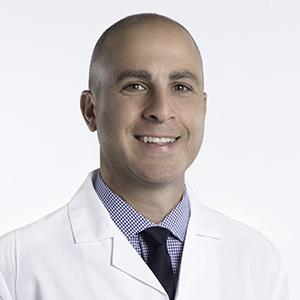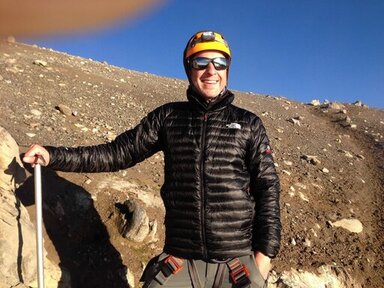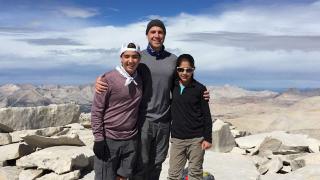
Growing up in Beirut, Lebanon, Saro H. Armenian, D.O., M.P.H., chair and professor in the City of Hope® of Hope Children’s Cancer Center, did not aspire to become a physician. Instead, he thought he might become a photojournalist. Growing up during the Lebanese Civil War, which lasted from 1975 to 1990, he dreamed of documenting this pivotal time in his country’s history.
“I was always drawn to excitement, and I could see myself one day becoming a photojournalist. That would have been a dream job. Growing up during a civil war, there was constant turmoil, but for whatever reason, I was drawn to documenting and capturing the chaos and stories around us,” explained Armenian, the Barron Hilton Chair in Pediatrics.
Cancer Hits Home
Fueled by religious and political divisions among various groups, the Lebanese Civil War caused significant social and economic devastation, resulting in the displacement of nearly 1 million residents. Armenian, his parents and younger sister were among those who left the country, immigrating to the United States in 1986 and settling in Baltimore when he was 12.
“I grew up in a very tight-knit Armenian community, so moving was quite an adjustment,” he remembered. “I went from a class of six students in a small private school to 450 students in a large public school in Baltimore. Obviously, I didn't know the language that well, didn't know the customs, didn't know how to be cool. I wore a tie to my first day of school.”
Armenian began settling into his new normal, learning English and adopting American customs despite the initial culture shock.
“Kids are resilient, and I was at an age when I was able to adapt culturally, socially and language-wise. Still, there was this unsettling undercurrent throughout my teenage years.”
That simmering unease reached a boiling point when Armenian’s younger sister, Areen, was diagnosed with leukemia just a few years after the family arrived in the U.S. She was only 10 years old.
“She was diagnosed with cancer at a young age. She had a very difficult type of leukemia to treat, and she ultimately had to undergo two stem cell transplants,” Armenian shared.
The whole family struggled to come to terms with Areen’s shocking diagnosis and felt its impact in different ways. While his sister fought for her life, Armenian’s parents had to wade through a complex American health care system that was unknown to them.
“I don't know how my parents navigated it all. As a father of two myself, I can't even imagine navigating something like that in another country — in another universe, as far as they're concerned,” he said.
As for Armenian, he tried his best to support his little sister while also maintaining some sort of normalcy in his own life. This proved difficult, however, when he became his sister’s stem cell donor for both of her transplants.
“I was trying to balance normal teenage life with the setbacks my sister faced, but I always knew that there was something different about our lives. This separated me from my peers, and I was keenly aware of that,” he said.
“I was also very much aware of the frailty of life.”
Developing a Passion for Pediatric Hematology and Oncology
Before Areen fell ill, Armenian had not considered medicine as a career, but his experience as both a stem cell donor and family member to a cancer patient was a turning point for him.
“In hindsight, I recognize how formative those relationships were with the providers who cared for her through her cancer treatment journey, and how profound those relationships can be. Eventually, I came to realize that this was the only thing I could see myself doing,” he explained.
Sadly, Areen passed away from complications related to her treatment, but her legacy lives on through Armenian’s work.
“Maybe my past has given me some insights and the empathy to understand what a cancer patient and their family go through. I can put myself in their shoes and understand their concerns, anxieties and fears,” he said.
“When you've really connected with a family and they know you understand them, you’ve built a relationship that speaks to the fundamentals of what we should be doing as humans — connecting with one another in a meaningful way and helping when we can,” he added.
Armenian’s personal experience has also helped shape who he is as a physician and how he cultivates deep, lasting relationships with his patients and their families.
“Not only do I take care of patients who are newly diagnosed with cancer, but I also see them 10 to 15 years or more beyond their diagnosis. I've been to weddings and graduations. They’re very personal relationships and represent some of the most rewarding experiences of my life,” he said.
The Path to City of Hope
Armed with a newfound passion and determination to help young cancer patients like Areen, Armenian completed his undergraduate education at the University of Chicago and earned his medical degree from Western University of Health Sciences in Pomona, California.
Knowing he wanted to specialize in pediatric blood cancers, he completed his residency and fellowship at Children’s Hospital Los Angeles (CHLA). In addition, Armenian earned his Master of Public Health degree from the University of Southern California.
It was Armenian’s fellowship at CHLA that would eventually bring him to City of Hope.
“During fellowship training, we all worked on a specific research project. At the time, my clinical mentor at CHLA suggested I look into this emerging field in the pediatric cancer community called cancer survivorship,” he recalled.
“We were starting to understand that there were real consequences of the therapies that many of these children received, and the world's authority in that field, Smita Bhatia, M.D., M.P.H, was here at City of Hope. I decided to do my research project with her.”
After completing his fellowship, Armenian chose to continue his career at City of Hope, where he has remained.
“I was drawn to the mission of City of Hope, as well as the commitment to mentorship and supporting young investigators who want to pursue research as their primary path forward,” he said.
“I have had amazing mentors besides Dr. Bhatia, too, who made me think there was no other place I'd want to spend the rest of my academic career. From Dr. Rosen to Dr. Forman and so many others, I could never imagine any of this being possible without their remarkable support.”
A Leader in Childhood Cancer Survivorship
As the director of City of Hope’s Childhood, Adolescent and Young Adult Survivorship Program, Armenian has worked tirelessly to help improve the health outcomes of childhood and young adult-onset cancer patients.
One of Armenian’s key areas of research is cardiotoxicity in childhood cancer survivors. For those who have cancer as children and undergo chemotherapy, one potential long-term side effect is an increased risk of heart failure. To address this, Armenian and his team conducted a clinical trial that found that carvedilol, a blood vessel-relaxing medication, is safe for childhood cancer survivors to take and may even improve markers of heart injury sustained as a result of chemotherapy exposure. The study’s results were recently published in The Lancet Oncology.
“What we've seen is that cure can come at a cost, and that these survivors who are treated as children then go on to develop these devastating complications. The purpose of this study was to see if we can prevent those complications from occurring.” Armenian explained.
“This idea was born out of City of Hope and subsequently expanded to nearly 30 institutions around the country. It was incredibly reassuring that as a scientific community, we could band together to try to answer these very difficult questions. Ultimately, this sense of community and shared purpose is at the heart of what we do at City of Hope, and what fuels me to try to address the next set of problems for our patients and their families.”
An Adventurous Spirit

Outside of work, Armenian’s top priority is spending time with his wife, Christine, and their two children, Shant and Sareen. He also craves excitement, just as he did in his youth. He relishes the challenge of trail running in his spare time and in his quest for adventure, Armenian also enjoys mountaineering.
“I love being outdoors, and I especially love hiking. I've climbed a number of peaks around the world, from Kilimanjaro to Mount Rainier and Mount Whitney several times. It’s a passion I’ve picked up from my parents, who are avid hikers,” he said.
While Armenian has traversed mountains across continents, taken in spectacular views and pushed himself to the limit physically and mentally, he treasures the peaks he reaches with his patients most.
“To be able to walk with a family through the darkest of valleys but ultimately take them to the mountaintops of hope and cure, it's one of the best jobs in the world. I can't think of anything else I’d rather do with my life.”
Main photo: Armenian and his kids Shant and Sareen atop Mount Whitney.
